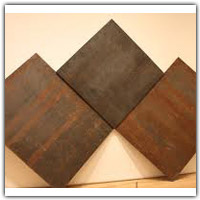 |
Also referred to as Atmospheric Corrosion Resistant Steel, Weathering means that due to their chemical compositions COR-TEN A and COR-TEN B steels, when utilised unprotected, exhibits increased resistance to atmospheric corrosion compared to unalloyed steels. This is because it forms a protective layer on its surface under the influence of the weather.
The corrosion retarding effect of the protective layer is produced by the nature of its structure components and the particular distribution and concentration of alloying elements in it. The layer protecting the surface develops and regenerates continuously when subjected to the influence of the weather.
|
Formation, duration of development and protective effect of the covering layer on weathering steels depend largely upon the corrosive character of the atmosphere. Its influence varies and depends mainly upon general weather condition (e.g. continental) macroclimate (e.g. industrial, urban, maritime or countryside climate) and the orientation of the structure components (e.g. exposed to or shaded from the weather, vertical or horizontal position). The amount of aggressive agents in the air has to be taken into account. In general the covering layer offers protection against atmospheric corrosion in industrial, urban and countryside climate.
When utilising this steel in unprotected condition it is up to the designer to take into account the expected loss of thickness due to corrosion and as far as necessary, compensate for it by increasing the thickness of the material.
In cases of particular air pollution by aggressive agents conventional surface protection is recommended. Coating is absolutely necessary in cases of contact with water for long periods, when permanently exposed to moisture, or if it is to be used in the vicinity of the sea. The susceptibility of paint coats to undercreepage by rust is less in the case of weathering steel than in the case of comparable non-weathering steel.
|
 Chemical Composition (heat analysis, %) Chemical Composition (heat analysis, %)
| Grade |
C |
Si |
Mn |
P |
S |
Cr |
Cu |
V |
Ni |
| COR-TEN A |
0.12 |
0.25-0.75 |
0.20-0.50 |
0.07-0.15 |
0.030 |
0.50-1.25 |
0.25-0.55 |
|
0.65 |
| COR-TEN B |
0.16 |
0.30-0.50 |
0.80-1.25 |
0.030 |
0.030 |
0.40-0.65 |
0.25-0.40 |
0.02-0.10 |
0.40 |
|
|
In order to obtain fine grain structure a sufficient amount of nitrogen absorbing elements is added (e.g. ≥0.02% Al).
Mechanical Properties, in the state of delivery condition
At room temperature for plates ≥3mm in thickness (transverse test specimans, according to EN 10002). Requirements to hot rolled plates ≤3mm in thickness according to EN 10025-5. |
| Grade |
Minimum
yield point
(ReH Mpa *) |
Tensile
strength
Rm MPa |
Minimum
elongation
A (Lo=5.65
√So) % |
| COR-TEN A |
355 |
470-630 |
20 |
|
|
*) 1 Mpa = 1N/mm2
In case of cold rolled material the yield point is min. 310 Mpa and the tensile strength min. 445 MPa. Furthermore cold rolled sheets ≤3mm in thickness made of steel grade COR-TEN A-F for increased demand to the cold formability is available. Mechanical properties: Yield point min. 275 Mpa; Tensile strength min. 410 Mpa; elongation min. 25%. Tolerances on dimensions and shape according to EN 10131.
Application Corrosion resistant steel - Weathering Steel grade
The steel is used for various types of welded, bolted and riveted constructions e.g. steel frame structures, bridges, tanks and containers, exhaust systems, vehicles and equipment constructions.
|
|